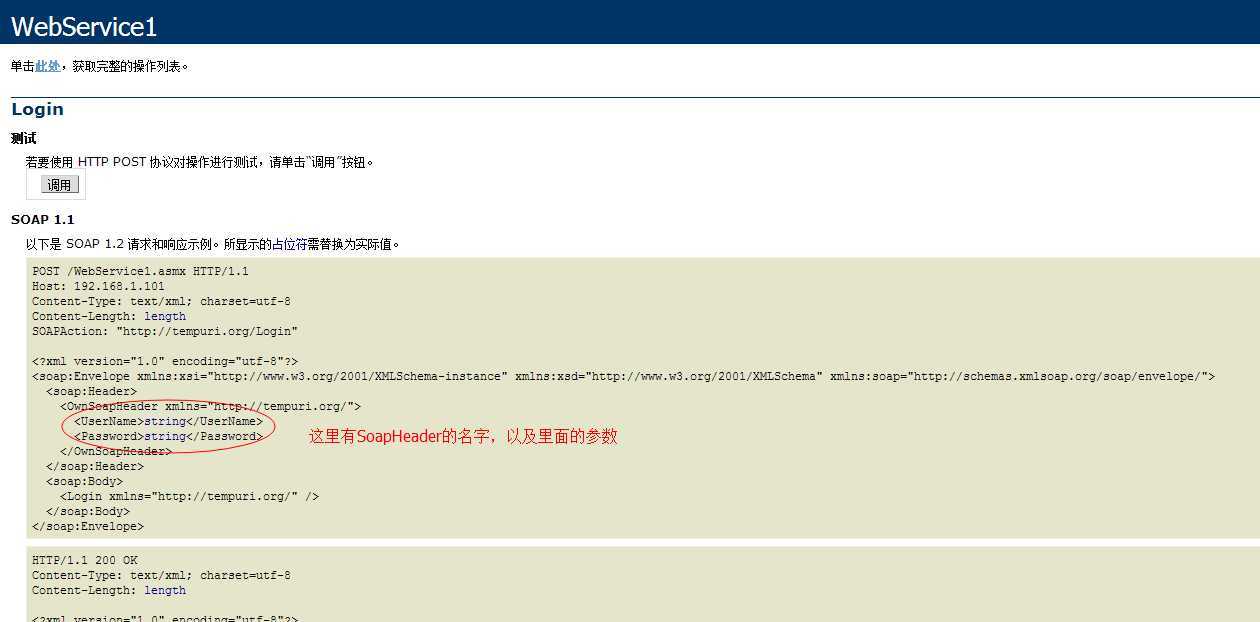标签:style blog http color io os 使用 ar for
关于这个问题,如果使用百度都是前篇一律的代码,好不容易上了google才找到完整的方法,这里讲所有的代码都贴出来与大家分享。
首先是.NET写的后台代码
/// <summary> /// SoapHeader /// </summary> public class OwnSoapHeader:SoapHeader { public string UserName { get; set; } public string Password { get; set; } } /// <summary> /// WebService1 的摘要说明 /// </summary> [WebService(Namespace = "http://tempuri.org/")] [WebServiceBinding(ConformsTo = WsiProfiles.BasicProfile1_1)] [System.ComponentModel.ToolboxItem(false)] // 若要允许使用 ASP.NET AJAX 从脚本中调用此 Web 服务,请取消注释以下行。 // [System.Web.Script.Services.ScriptService] public class WebService1 : System.Web.Services.WebService { public OwnSoapHeader OwnSoapHeader; [WebMethod] [SoapHeader("OwnSoapHeader")] public string Login() { if (OwnSoapHeader != null) { return OwnSoapHeader.UserName + "," + OwnSoapHeader.Password; } return "尚未登录"; } }
接下来是在浏览器中浏览查看我的接口,这里面有很重要的信息,包含了SoapHeader的名字以及参数

随后就是使用Ksoap2调用我的接口了
private void DoLogin() {
new Thread() {
@Override
public void run() {
Looper.prepare();
// TODO Auto-generated method stub
String sNameSpace = "http://tempuri.org/";
String sMethodName = "Login";
String sActionString = "http://tempuri.org/Login";
String sURL = "http://192.168.1.101:8088/WebService1.asmx";
SoapObject rpc = new SoapObject(sNameSpace, sMethodName);
//在这里加入了SoapHeader
Element[] header = new Element[1];
//OwnSoapHeader与上图红色标记处名字一致
header[0] = new Element().createElement(sNameSpace, "OwnSoapHeader ");
//UserName上图红色标记处名字一致
Element username = new Element().createElement(sNameSpace,
"UserName");
username.addChild(Node.TEXT, "admin");
header[0].addChild(Node.ELEMENT, username);
//Password上图红色标记处名字一致
Element pass = new Element().createElement(sNameSpace,
"Password");
pass.addChild(Node.TEXT, "123");
header[0].addChild(Node.ELEMENT, pass);
SoapSerializationEnvelope envelope = new SoapSerializationEnvelope(
SoapEnvelope.VER12);
envelope.headerOut = header;
envelope.bodyOut = rpc;
envelope.dotNet = true;
envelope.setOutputSoapObject(rpc);
HttpTransportSE ht = new HttpTransportSE(sURL);
SoapObject soapObject = null;
try {
ht.call(sActionString, envelope);
soapObject = (SoapObject) envelope.bodyIn;
} catch (IOException ex) {
// TODO Auto-generated catch block
ex.printStackTrace();
} catch (XmlPullParserException ex) {
// TODO Auto-generated catch block
ex.printStackTrace();
}
Bundle result = new Bundle();
if (soapObject != null) {
result.putString("result", soapObject.toString());
} else {
result.putString("result", sURL);
}
Message msg = new Message();
msg.setData(result);
msg.what = 1;
handler.handleMessage(msg);
Looper.loop();
}
}.start();
}
Handler handler = new Handler() {
@Override
public void handleMessage(Message msg) {
// TODO Auto-generated method stub
if (msg.what == 1) {
Bundle result = msg.getData();
String text = result.getString("result");
Toast.makeText(MainActivity.this, text, Toast.LENGTH_LONG)
.show();
}
}
};
至此已经全部OK了,能够接收到服务端回发的用户数据
使用Ksoap2调用Web Service加入SoapHeader
标签:style blog http color io os 使用 ar for
原文地址:http://www.cnblogs.com/wangq0126/p/3980205.html